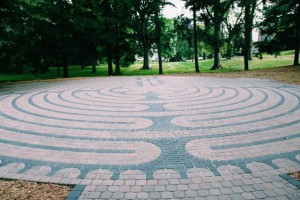By: Tom Wolber, associate professor of German

Thanks to a generous gift from the Rhinesmith family, Ohio Wesleyan University now has a spiritual labyrinth. Modeled after the circular labyrinth at Chartres Cathedral near Paris, it is situated in the shady, idyllic grove between Merrick Hall and the Delaware Run where it blends into the landscape. The official dedication and asperging (cleansing and blessing with water) took place on Monday, Oct. 5, 2015. But the labyrinth had already seen hundreds of curious visitors before that, after it was completed just prior to the start of the 20152016 academic year.
Passersby are clearly intrigued, but many may wonder what it all means and how it relates to OWU’s mission. Here is a humble attempt to explain some of the mysteries.
A labyrinth is not a maze, with false leads and dead ends. Unlike a maze where you lose your way, OWU’s labyrinth has a single trustworthy path that can help you find your way. However, that path follows an enigmatic series of 35 tracks that take the visitor through eleven circuits divided into four quadrants each. With a circumference of 47 feet (about 15 meters), the total length approaches 1,000 feet (about 300 meters). During medieval times, pilgrims are said to have negotiated the circuitous path on their knees, which was both humbling and challenging.
That the labyrinth is sacred ground and a magical place is obvious. For some, it may simply be a sanctuary to patiently sit and rest for a while and to meditate in peace and quiet – a much-needed respite in our noisy, fast-moving world. There is a demand for retreats that encourage introspection. For others, the path may simply be a metaphor for the many unpredictable twists and turns that the journey of life has in store for us. The path can also be seen as a teacher in the never-ending quest for knowledge and enlightenment. That would certainly jive with OWU’s educational mission. Is the path the key to a deeper understanding of the human condition, both conscious and subconscious? That, too, would be a perfectly plausible explanation. Some look at labyrinths as medicine tools and their paths as vehicles for hope and healing of that which is broken. Is it the path to the mysteries of the divine? That, likewise, goes well with OWU’s legacy as a religious institution founded by Methodism. The labyrinth is probably all of the above, and more. Thus, it is a laboratory where all kinds of research can be conducted, epiphanies had, and discoveries made. For example, some scholars have argued that the four quadrants may represent the four earthly elements of water, fire, earth, and air and that the twelve circles (including the center) may represent the planetary zodiac signs.
The labyrinth is symbolic of the indomitable quest for truth and fulfillment. It is a place where the body and the mind connect. Essentially built with rock and sand, the labyrinth nevertheless allows visitors to leave behind everything that is earthly and to soar above the mundane. It is a testimony to the dual nature of humankind, which is at home in both the physical (flesh) and metaphysical (spirit). Also, is it a coincidence that the convoluted path of the labyrinth is reminiscent of the twists and turns of the human brain, resembling a map and a blueprint? This labyrinth, and all mazes and labyrinths, has archetypal depth and fulfills a primal need, for “man does not live by bread alone.” Thus, the labyrinth is a mystical place that allows us to dream and to raise our soul to a higher level. It is also a place where body and soul, solitude and community, freedom and captivity, heaven and earth, cosmos and chaos meet and form a mystical “coincidentia oppositorum” where time and space are suspended and transcended. As such, however, the labyrinth also instructs us that certain things will forever remain unknowable and unfathomable, given the limits of human epistemological understanding.
Life Trustee Kathe Law Rhinesmith, class of 1964, has referred to the labyrinth as a tribute to and celebration of the human spirit and soul. She has also made it clear that OWU’s labyrinth is not about proselytizing. Instead, it was constructed with a non-denominational, non-sectarian goal in mind. The labyrinth is intended to resonate with people of all faiths, or no faith at all. The internationally renowned builder, Marty Kermeen of Illinois-based Labyrinths in Stone, and his assistant, David Keller, are in agreement with that tenet, pointing out that labyrinths have been in existence for many millennia, pre-dating Christianity by thousands of years. The labyrinth is also designed to be open and accessible to the public – school children, church members, concertgoers and dog walkers. There are no barriers, fees, or rules of any kind. Everyone is invited to seek knowledge and wisdom. The labyrinth does not require that its path be followed.
But the path is there, patiently awaiting anyone ready and willing to go on a transformational adventure.
